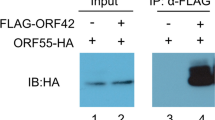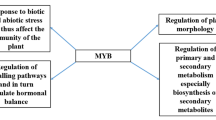Abstract
Aurora kinase (AUR) is a well-known mitotic serine/threonine kinase that regulates centromere formation, chromosome segregation, and cytokinesis in eukaryotes. In addition to regulating mitotic events, AUR has been shown to regulate protein dynamics during interphase in animal cells. In contrast, there has been no identification and characterization of substrates and/or interacting proteins during interphase in plants. The Arabidopsis thaliana genome encodes three AUR paralogues, AtAUR1, AtAUR2, and AtAUR3. Among them, AtAUR1 and AtAUR2 are considered to function redundantly. Here, we confirmed that both AtAUR1 and AtAUR3 are localized in the nucleus and cytoplasm during interphase, suggesting that they have functions during interphase. To identify novel interacting proteins, we used AlphaScreen to target 580 transcription factors (TFs) that are mainly functional during interphase, using recombinant A. thaliana TFs and AtAUR1 or AtAUR3. We found 133 and 32 TFs had high potential for interaction with AtAUR1 and AtAUR3, respectively. The highly AtAUR-interacting TFs were involved in various biological processes, suggesting the functions of the AtAURs during interphase. We found that AtAUR1 and AtAUR3 showed similar interaction affinity to almost all TFs. However, in some cases, the interaction affinity differed substantially between the two AtAUR homologues. These results suggest that AtAUR1 and AtAUR3 have both redundant and distinct functions through interactions with TFs. In addition, database analysis revealed that most of the highly AtAUR-interacting TFs contained a detectable phosphopeptide that was consistent with the consensus motifs for human AURs, suggesting that these TFs are substrates of the AtAURs. The AtAURs phosphorylated several highly interacting TFs in the AlphaScreen in vitro. Overall, in line with the regulation of TFs through interaction, our results indicate the possibility of phosphoregulation of several TFs by the AtAURs (280/300).





Similar content being viewed by others
References
Alexander J, Lim D, Joughin BA, Hegemann B, Hutchins JRA, Ehrenberger T, Ivins F, Sessa F, Hudecz O, Nigg EA, Fry AM, Musacchio A, Stukenberg PT, Mechtler K, Peters JM, Smerdon SJ, Yaffe MB (2011) Spatial exclusivity combined with positive and negative selection of phosphorylation motifs is the basis for context-dependent mitotic signaling. Sci Signal 4:ra42
Allen JJ, Li M, Brinkworth CS, Paulson JL, Wang D, Hubner A, Chou W-H, Davis RJ, Burlingame AL, Messing RO, Katayama CD, Hedrick SM, Shokat KM (2007) A semisynthetic epitope for kinase substrates. Nat Meth 4:511–516
Ban R, Matsuzaki H, Akashi T, Sakashita G, Taniguchi H, Park SY, Tanaka H, Furukawa K, Urano T (2009) Mitotic regulation of the stability of microtubule plus-end tracking protein EB3 by ubiquitin ligase SIAH-1 and Aurora mitotic kinases. J Biol Chem 284:28367–28381
Berardini TZ, Mundodi S, Reiser L, Huala E, Garcia-Hernandez M, Zhang PF, Mueller LA, Yoon J, Doyle A, Lander G, Moseyko N, Yoo D, Xu I, Zoeckler B, Montoya M, Miller N, Weems D, Rhee SY (2004) Functional annotation of the Arabidopsis genome using controlled vocabularies. Plant Physiol 135:745–755
Bhatt AA, Etchells JP, Canales C, Lagodienko A, Dickinson H (2004) VAAMANA—a BEL1-like homeodomain protein, interacts with KNOX proteins BP and STM and regulates inflorescence stem growth in Arabidopsis. Gene 328:103–111
Demidov D, Van Damme D, Geelen D, Blattner FR, Houben A (2005) Identification and dynamics of two classes of Aurora-like kinases in arabidopsis and other plants. Plant Cell 17:836–848
Frangini A, Sjoeberg M, Roman-Trufero M, Dharmalingam G, Haberle V, Bartke T, Lenhard B, Malumbres M, Vidal M, Dillon N (2013) The aurora B kinase and the polycomb protein Ring1B combine to regulate active promoters in quiescent lymphocytes. Mol Cell 51:647–661
Fujiwara T, Hirai MY, Chino M, Komeda Y, Naito S (1992) Effects of sulfur nutrition on expression of the soybean seed storage protein genes in transgenic petunia. Plant Physiol 99:263–268
Hengeveld RCC, Hertz NT, Vromans MJM, Zhang C, Burlingame AL, Shokat KM, Lens SMA (2012) Development of a chemical genetic approach for human aurora B kinase identifies novel substrates of the chromosomal passenger complex. Mol Cell Proteom 11:47–59
Kawabe A, Matsunaga S, Nakagawa K, Kurihara D, Yoneda A, Hasezawa S, Uchiyama S, Fukui K (2005) Characterization of plant Aurora kinases during mitosis. Plant Mol Biol 58:1–13
Kettenbach AN, Schweppe DK, Faherty BK, Pechenick D, Pletnev AA, Gerber SA (2011) Quantitative phosphoproteomics identifies substrates and functional modules of aurora and polo-like kinase activities in mitotic cells. Sci Signal 4:rs5
Koizumi K, Wu S, MacRae-Crerar A, Gallagher KL (2011) An essential protein that interacts with endosomes and promotes movement of the SHORT-ROOT transcription factor. Curr Biol 21:1559–1564
Kumimoto RW, Zhang Y, Siefers N, Holt BF (2010) NF-YC3, NF-YC4 and NF-YC9 are required for CONSTANS-mediated, photoperiod-dependent flowering in Arabidopsis thaliana. Plant J 63:379–391
Kurihara D, Matsunaga S, Kawabe A, Fujimoto S, Noda M, Uchiyama S, Fukui K (2006) Aurora kinase is required for chromosome segregation in tobacco BY-2 cells. Plant J 48:572–580
Kurihara D, Kawabe A, Matsunaga S, Nakagawa K, Fujimoto S, Uchiyama S, Fukui K (2007) Characterization of a splicing variant of plant Aurora kinase. Plant Cell Physiol 48:369–374
Kurihara D, Matsunaga S, Uchiyama S, Fukui K (2008) Live cell imaging reveals plant Aurora kinase has dual roles during mitosis. Plant Cell Physiol 49:1256–1261
Martinelli F, Reagan RL, Uratsu SL, Phu ML, Albrecht U, Zhao W, Davis CE, Bowman KD, Dandekar AM (2013) Gene regulatory networks elucidating huanglongbing disease mechanisms. PLoS One 8:e74256
Nakagawa T, Kurose T, Hino T, Tanaka K, Kawamukai M, Niwa Y, Toyooka K, Matsuoka K, Jinbo T, Kimura T (2007) Development of series of gateway binary vectors, pGWBs, for realizing efficient construction of fusion genes for plant transformation. J Biosci Bioeng 104:34–41
Nemoto K, Seto T, Takahashi H, Nozawa A, Seki M, Shinozaki K, Endo Y, Sawasaki T (2011) Autophosphorylation profiling of Arabidopsis protein kinases using the cell-free system. Phytochem 72:1136–1144
Nemoto K, Takemori N, Seki M, Shinozaki K, Sawasaki T (2015) Members of the plant CRK-superfamily are capable of trans-/auto-phosphorylation of tyrosine residues. J Biol Chem 290:16665–16677
Nozawa A, Matsubara Y, Tanaka Y, Takahashi H, Akagi T, Seki M, Shinozaki K, Endo Y, Sawasaki T (2009) Construction of a protein library of Arabidopsis transcription factors using wheat cell-free protein production system and its application for DNA binding analysis. Biosci Biotechnol Biochem 73:1661–1664
Papuga J, Hoffmann C, Dieterle M, Moes D, Moreau F, Tholl S, Steinmetz A, Thomas C (2010) Arabidopsis LIM proteins: a family of actin bundlers with distinct expression patterns and modes of regulation. Plant Cell 22:3034–3052
Petrovska B, Cenklova V, Pochylova Z, Kourova H, Doskocilova A, Plihal O, Binarova L, Binarova P (2012) Plant Aurora kinases play a role in maintenance of primary meristems and control of endoreduplication. New Phytol 193:590–604
Rosa S, Ntoukakis V, Ohmido N, Pendle A, Abranches R, Shaw P (2014) Cell differentiation and development in Arabidopsis are associated with changes in histone dynamics at the single-cell level. Plant Cell 26:4821–4833
Sawasaki T, Ogasawara T, Morishita R, Endo Y (2002) A cell-free protein synthesis system for high-throughput proteomics. Proc Natl Acad Sci USA 99:14652–14657
Sawasaki T, Morishita R, Gouda MD, Endo Y (2007) Methods for high-throughput materialization of genetic information based on wheat germ cell-free expression system. Methods Mol Biol 375:95–106
Schlereth A, Moller B, Liu W, Kientz M, Flipse J, Rademacher EH, Schmid M, Juergens G, Weijers D (2010) MONOPTEROS controls embryonic root initiation by regulating a mobile transcription factor. Nature 464:913–916
Shen H, Cao K, Wang X (2007) A conserved proline residue in the leucine zipper region of AtbZIP34 and AtbZIP61 in Arabidopsis thaliana interferes with the formation of homodimer. Biochem Biophys Res Commun 362:425–430
Takai K, Sawasaki T, Endo Y (2010) Practical cell-free protein synthesis system using purified wheat embryos. Nat Protoc 5:227–238
Tomastikova E, Demidov D, Jerabkova H, Binarova P, Houben A, Dolezel J, Petrovska B (2015) TPX2 protein of arabidopsis activates aurora kinase 1, but not aurora kinase 3 in vitro. Plant Mol Biol Reporter 33:1988–1995
Truernit E, Haseloff J (2007) A role for KNAT class II genes in root development. Plant Sig Behav 2:10–12
Van Damme D, Bouget FY, van Poucke K, Inze D, Geelen D (2004) Molecular dissection of plant cytokinesis and phragmoplast structure: a survey of GFP-tagged proteins. Plant J 40:386–398
Van Damme D, De Rybel B, Gudesblat G, Demidov D, Grunewald W, De Smet I, Houben A, Beeckman T, Russinova E (2011) Arabidopsis alpha Aurora kinases function in formative cell division plane orientation. Plant Cell 23:4013–4024
Weimer AK, Demidov D, Lermontova I, Beeckman T, Van Damme D (2016) Aurora kinases throughout plant developoment. Trends Plant Sci 21:69–79
Zheng FM, Yue CF, Li GH, He B, Cheng W, Wang X, Yan M, Long ZJ, Qiu WS, Yuan ZY, Xu J, Liu B, Shi Q, Lam EWF, Hung MC, Liu QT (2016) Nuclear AURKA acquires kinase-independent transactivating function to enhance breast cancer stem cell phenotype. Nat Commun 7:10180
Acknowledgments
We thank Dr. D. Van Damme for providing the transgenic plant proAtAUR1::genomicAtAUR1-GFP, Dr. T. Nakagawa for providing pGWB4, and Y. Nakamura for technical assistance. This work was supported by CREST Grants from the Japan Science and Technology Agency to S.M., MXT/JSPS KAKENHI to S.M. (26291067, 15H01238, 15H05962), and JSPS KAKENHI to T. Sakamoto (25113002); Platform for Drug Discovery, Informatics, and Structural Life Science to T. Sawasaki.
Author information
Authors and Affiliations
Corresponding author
Additional information
M. Takagi and T. Sakamoto equally contributed to this work.
Electronic supplementary material
Below is the link to the electronic supplementary material.
Rights and permissions
About this article
Cite this article
Takagi, M., Sakamoto, T., Suzuki, R. et al. Plant Aurora kinases interact with and phosphorylate transcription factors. J Plant Res 129, 1165–1178 (2016). https://doi.org/10.1007/s10265-016-0860-x
Received:
Accepted:
Published:
Issue Date:
DOI: https://doi.org/10.1007/s10265-016-0860-x




